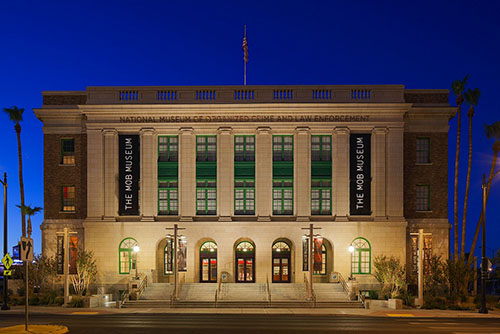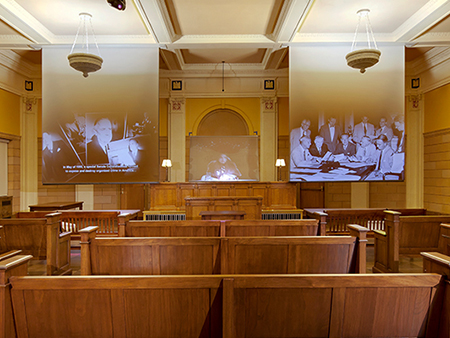From Courthouse to Mob Museum: Preserving our Historic Past
 By Jessica Glavin
By Jessica Glavin
GSA is the steward of nearly 500 historic buildings across the nation. Each May we celebrate Preservation Month to honor the historic past of our federal buildings. But the agency doesn’t always hang on to all of the historic properties in its inventory; so what happens to the buildings the federal government no longer needs?
Once a building is no longer needed, GSA helps properly dispose of the property. Oftentimes the best use of a historic building is to repurpose it for a new use, while maintaining its historical significance under a historic monument conveyance. This was the case for the U.S. Courthouse in Las Vegas, which is now home to the Mob Museum.
Steps away from the historic Fremont Street corridor in downtown Las Vegas and directly adjacent to the old city hall, the three-story U.S. Courthouse and Post Office originally opened in 1933. In 1983, the building was added to the National Register of Historic Places. But by the early 2000s it was determined that the building was no longer needed in the federal inventory and GSA began looking at disposal options for the property.
This project was one of the first disposals for David Haase, then realty specialist, now Director of the Real Property Utilization and Disposal Division for Region 9. “This transaction typifies the genius of the disposal process” said Haase. “GSA has the tools to foster reuse and redevelopment of unneeded federal property to meet local desires while preserving the legacy of a historic resource”.
The City of Las Vegas expressed an interest in the courthouse and in 2002, GSA granted the deed for the building to the City under a no-cost historic monument conveyance, with the requirement that the building be utilized for public benefit. As a part of the deal, the last remaining federal tenants were also able to stay in the building via a leaseback agreement, before moving to the Foley Federal Building and U.S. Courthouse in 2004.
After a complete renovation and restoration, the building reopened in 2012 as the National Museum of Organized Crime and Law Enforcement, more commonly referred to as the Mob Museum. Last year, the museum had an annual attendance of over 350,000, hosting tourists from all over the world.
“Our building is on the National Register of Historic Places and we are very careful to maintain its historical integrity throughout all exhibit floors,” said Geoff Schumacher, Senior Director of Content.

Visitors to the museum can sit in the same courtroom that held the infamous Kefauver trials held in the early 1950s, questioning casino owners and managers about ties to the mob and organized crime. “The courtroom is our most exciting feature,” said Schumacher. “It has been restored by conservators and features original furniture. Once inside, our visitors are transported to mid-century Las Vegas and the excitement of the Kefauver hearings that were held in that very room.”
Schumacher also pointed out the impact other federal agencies have had on the non-profit museum. “Many federal agencies have contributed research, knowledge and records that went into the making of our exhibits. The FBI and IRS have also contributed several exciting items to our artifact collection. The most recent of these from the IRS is a gun confiscated from Al Capone that can be found on the third floor.”
In addition to the historic 2nd-floor courtroom, the museum still radiates with neoclassical charm throughout, even utilizing the old post office counters as the ticket booths. In a city renowned for demolishing old casinos in favor of new shiny buildings, it’s nice to see a neoclassical building, and the first courthouse in Las Vegas, preserved and put to positive use.

 U.S. General Services Administration
U.S. General Services Administration